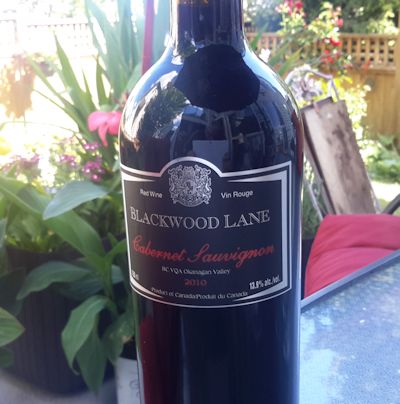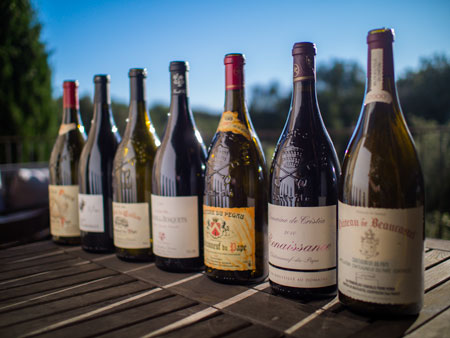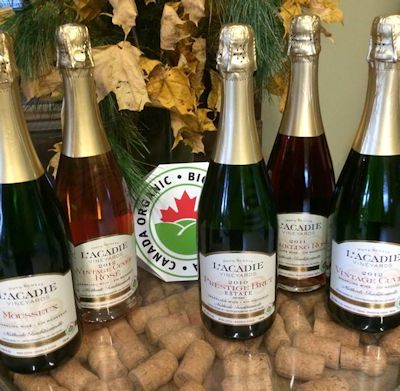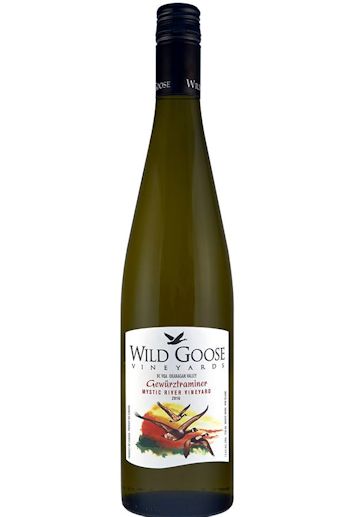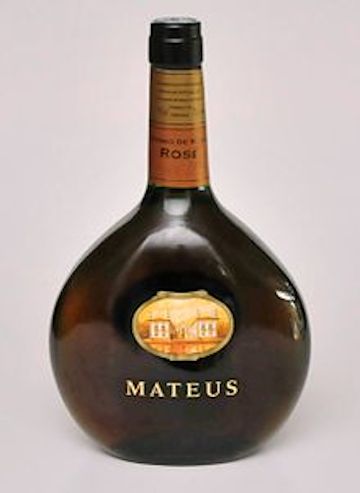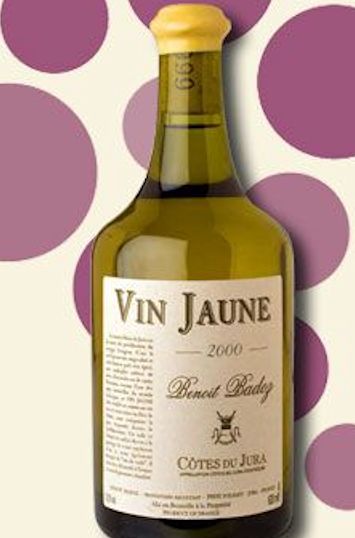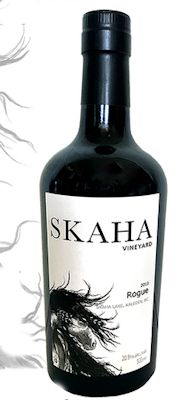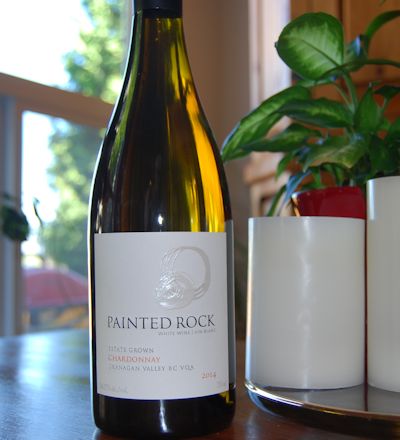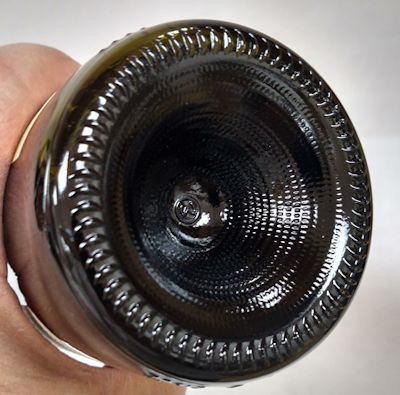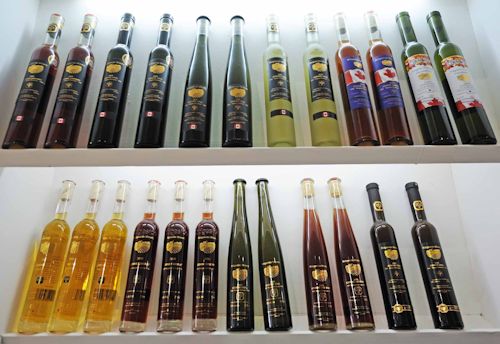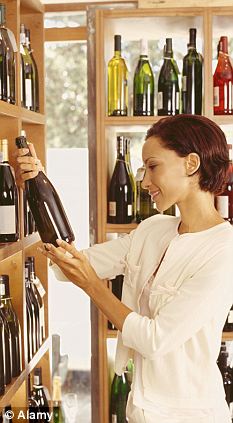Robert Bell's
Wines of Canada
Since 1992
Wine Bottles
Wine Bottles are not created equal
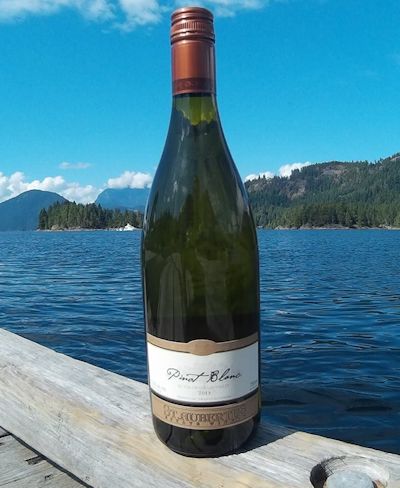
"It's is the market perception that still dictates the style/form of bottle"
Ulrich Andy Gebert
Many years ago, wine producers in Europe created wine bottles that were unique to their growing area
How often do you thing about the bottle the wine comes in? Apparently the size and shape of the bottle has some importance . Those who are quite serious about their wines know that there very specific bottles for various wines. There are traditions, which is why most Rieslings come in long-necked bottles and most Chardonnays in shorter slope shoulder bottles fat around the waist. The straight-sided Bordeaux bottle is used for most Bordeaux red varieties and some whites, like Sauvignon Blanc.
Wine bottles have their own history, however today there are 12 basic different wine bottles. The shape of the bottle does not make a difference in terms of impacting the wine’s flavour, the bottle chosen does often represent a good amount of history and tradition that reflects back to where the wine is made.
The familiar wine bottle came into being in the 17th century. Prior to this wine was stored in amphora or casks. The cork came first The Amphta (also spelled Amphorae) was sealed with cork.
Bordeaux
Straight and tall stature with high shoulders, this bottle is widely used for the wine we all conveniently reference to as Bordeaux. The glass is dark green for reds, and light green or clear for whites. The Bordeaux bottle is often used as a broad term for a wide variety of grapes: Cabernet Sauvignon , Merlot, Malbec, Sauvignon Blanc, Chenin Blanc, Semillon, Sauternes and most Meritage or Bordeaux blends. However, it is not always “Bordeaux”
Burgundy
Classic, yet elegant, the Burgundy (Bourgogne) bottle features gently sloping shoulders and a slightly wider body than the rest. Both reds and whites use a dark green coloured glass. This bottle is primarily used for Pinot Noir, Aligoté and Chardonnay. Just like Bordeaux, the Burgundy bottle is also used for wines produced in other regions of France, notably the Loire Valley. Due to its popularity, the Burgundy bottle is often stylized. Bottle designers make a bottle with a thicker glass and a fatter girth, frequently used to bottle Pinot Noir.Invented sometime in the nineteenth century, it is thought that the bottle’s curved sides exist simply because this design was easier for glass-makers to create.
Rhône
This bottle looks a lot like the Burgundy bottle, perhaps just a little thinner and taller. The neck is marginally longer, with more angular sloping shoulders. Rhône bottles are often embossed with a coat of arms below the neck. This style is used for Grenache, Mourvèdre, Syrah, and other grape varieties. Châteauneuf-du-Pape and Côtes-du-Rhône, two of the most popular wines of the Rhône region, proudly use this bottle, as well as “New World” Shiraz wines produced in other countries (Argentina, Australia, Canada, Chile, New Zealand, South Africa and the United States). Generally green coloured glass, this shape is primarily used for reds, while whites and roses use clear glass.
Syrah is the most common wine found in this type of bottle but Grenache, Mourvedre, Viognier, Roussanne and Marsanne are also likely candidates to be served in this wine bottle shape.
Champagne
This olive-green bottle represents joy and happiness, and gets invited to many parties and weddings around the world. Sturdy, yet graceful, this bottle’s design is originally based on technical necessities as opposed to style. Its thick glass, gentle sloping shoulders and deep punt are quite essential to avoid a big mess! Champagne is a carbonated or “sparkling” wine, and the pressure can get as high as 80 to 90 psi (3 times the pressure inside a typical tire). Back in the early days of making Champagne, bottles used to explode during transportation. Never mind the perilous aspect of the job, it was such a waste! Keeping all that pressure inside the bottle also requires a larger and reversed tapered cork. A third of the cork will remain outside of the bottle allowing for an easy grip while opening the bottle – unless you know how to saber Champagne bottles ;) In addition to being a technical necessity, the punt is also used by the sommelier to help pour the wine, providing a grip for the thumb at the bottom of the bottle.
Champagne bottles were created to enhance both the beauty of the bottle shape and for practical reasons. Practicality comes into play in Champagne because the bottles needed to be stronger, due to the pressures coming from the effervescence in Champagne. While Champagne bottles are obviously related to the pear shaped, Burgundy bottle, they are also different. Champagne bottles are usually slightly larger, heavier and feature larger, deeper punts for the reasons we mentioned. The bottles were invented at the same time that wine makers discovered how to produce Champagne, in 1662. Several Champagne producers have created their own, unique, patented Champagne bottle shapes to help their product stand out including Krug, Dom Perignon, Feuillatte Palmes d’Or, Cristal, Laurent Perrier and others. *
Champagne bases usually have deep punts/push-up's. The tirage cap used is a specialized strong crown cap with built-in bidule to keep sediments from the bottle lip. the ring on the neck secures the wirecage (which secures the cork)
Côtes de Provence
Though mostly used for rosé, this clear glass bottle is also used for red wine. There are still remnants of traditional winemaking in the Côtes de Provence and some producers still use the regional wine bottle which has a distinctive form that is between an amphora vessel and a bowling pin. Also called a “corset” by the locals for obvious reasons, this bottle shape has been used for decades.I cannot recall a Canadian winery using this bottle
Mosel & Alsace
These elegant bottles are tall and slim with a long neck, and generally made of a light green glass. Traditionally, wines from the Mosel (Germany) and Alsace (France) regions use it. It is used by wineries for several grape varieties including Riesling and Müller-Thurgau. Their wines can vary from dry to sweet (even sparkling), while “New World” winemakers tend to use this bottle for sweet wines only. In either case, label knowledge is always advised.
Rhine
Slightly thiner than its Mosel counterpart, this German bottle (once traditionally referred to as ‘hock’) features similar characteristics: tall, slim, a long neck and very little punt. The only obvious difference is the dark brown color of the glass, which sets them apart.It is used for similar grape varieties like Riesling, Müller-Thurgau, Bacchus, as well as the notorious and legendary Gewürztraminer. Riesling has a very strong presence amongst other wine wines, and it is often included in the “top three” white wine varieties together with Chardonnay and Sauvignon Blanc.
Chianti
Round body, bulged bottom, and partially covered with a close-fitting straw basket. Yes, I am talking about the one-of-a-kind Chianti bottle, also called a fiasco. Chianti is a red Italian wine produced in Tuscany. Most Chianti is now bottled in more standard shaped wine bottles (Bordeaux shape), though it is not unusual to see them on the shelves of your favourite wine store. The basket is typically made of a swamp weed (or raffia), sun-dried and blanched with sulfur. The glass bottle can have a round bottom, which is much simpler to make by glass blowing. The basket provides a flat base for the glass, as well as extra protection during transportation and handling. Fiaschi can be efficiently packed for transport, with the necks of upturned bottles safely tucked into the spaces between the baskets of upright ones. The use of this iconic Chianti bottle has decreased over the years, which is a real shame, given how popular they once used to be. So grab one of those before they are completely gone, and turn it into a candle holder! You won’t be the first one ;)
Bocksbeutel
Though its name translates to “beer bag”, this bottle is used for wine. Also known as Trollinger, the Bocksbeutel is a type of wine bottle with the form of a flattened ellipsoid, which contains exactly the same volume of wine as more traditional bottles (0.75 Liters).The short neck bottle often features an engraved emblem on the left shoulder, representing the name of the domain. This bottle is similar in shape to the field bottle (canteen), and are manufactured with a flattened shape for practical purposes; it is easier to carry around and it keeps the bottle from rolling away on uneven ground.
It is commonly used for wines from the Franconia region in Germany at least since the early 18th century, but is also used for some Portuguese wines, in particular rosés, where the bottle is called cantil. The Bocksbeutel is a protected bottle shape under the European Union.
Jura
This bottle’s little recognition and/or popularity. Featuring a light green color, the bottom half of the bottle is slightly flared, while the top half features inside curved shoulders that gently blend into the long neck. Located between Burgundy and Switzerland, Jura is a little gemstone in a sack of tiny rocks, where each sparkle is a drop of wine. Well known in the wine community, this northeast region of France produces wines from a wide range of grapes, including Savagnin, Poulsard, Trousseau, Pinot Noir, and Chardonnay; all of which use this inspiring bottle shape.Not used by Canada's wineries that I am aware of.
Vin Jaune
Associated with the Jura region of France for bottling Savagnin grapes, Vin Jaune wine is unique and incomparable to any other wines worldwide, and so is the bottle: short, stocky and heavily built. Also called “clavelin”, this bottle is the only bottle legally authorized for Vin Jaune. It only contains 62 cl (22 oz) which is approximately what’s left of 1 liter of wine before the maturation process starts. Vin Jaune needs to mature 6 years in a barrel under a film of yeast, known as the “voile”, before being bottled. This long and lonely journey makes it one of the most valued and respected wines in the world.
Bottle with similar characteristic were used in the early 1900's for Canada's early wines.
Fortified Wine
Similarly to the Bordeaux, this bottle features a straight body with high, rounded shoulders. Its most prominent attribute remains the bulged section of the neck, which prevents the sediments from being poured into the glass. By the same token, some of these bottles have a punt which is used to collect and retain those sediments towards the bottom. It is recommended to keep the bottle still while pouring, to keep their sediments undisturbed. The other distinctive aspect of this bottle is the use of a cork stopper, as opposed to the typical long cork. The extremely dark glass protects the wine from the light, and promotes better conservation. This bottle is used for fortified wines, such as Madeira, Marsala, Vermouth, and of course, Port.
Tortuga
The tortuga is often used for Porty style wines and fortified wines.
It is usually 500 ml and closed with a cork
"With my brand it's very important. I want one very focused message of quality. My bottles come from France and are made by Saver Glass. They are THE quality glass producers in the world. People notice the quality and it's very on brand." John Skinner - Painted Rock Winery.
Eco-Glass™ is an innovative, lightweight wine bottle that was designed with one thing in mind:
sustaining our environment. Made with 25% less glass than standard wine bottles, Eco-Glass
weighs significantly less than a standard bottle and requires much less fuel to transport. This
results in less carbon emissions and a reduced environmental impact, which ultimately leads
to a better, greener, more sustainable environment.The beauty of Eco-Glass is that, while it leaves a much smaller carbon footprint in its trail, the
wine inside is just as good. So enjoy a glass of wine packaged in Eco-Glass and help the planet, as doing good feels good.
Sparkling Wine
Champagne, or sparkling wine, bottles differ from your typical wine bottles in the amount of pressure it can handle. One company in North America makes only two bottles another company has 16 diferent designs.
Bruce Ewert, L'Acadie Vineyards: For sparkling bottles, the interface between the tirage cap and the bottle is very important so I have stayed with same French supplier since I was at Hawthorne Mtn. Many new suppliers have visited the winery over the years and left China bottles but I'm not willing to change/chance. We used to be the only one out here ( Nova Scotia) getting these bottles from France, about8-10 pallets/yr, but I've encouraged others to get them too and it has grown to several containers/yr delivered direct.
Thicker Glass
Many bottles are made with extra thick glass to keep out light for long term aging, also the heavy weight makes a more substantial and is more durable product.
Colour
The colour of your bottle says a lot about your wine. In addition to signaling your wine’s provenance and style, color often plays a part in protecting wine from harmful UV rays.
Why 750ml
David Ling at Hugel in Alsace when he uncovered a few tidbits. 750mL is roughly the average exhalation volume of the human lungs (in the context of glassblowing). Thus, it was the most common size when bottles were all made by human glassblowers – a tradition that has persisted into today’s regulated market. Specialist glassblowers were required to blow larger format bottles – magnums for instance.
Other reports say its simply the amount two people will consume.
Size matters
Wines meant to age usually come in dark bottles that protect wine from light. Wine ages better in larger bottles. The 375 ml bottle is not very good for aging wine. 750 ml is okay but the magnum (1.5 l) and larger sizes allow wines to age more gracefully. They are not seen often because they take up so much room in the cellar; and because you need to organize dinner parties around the large sizes.
Many of these larger bottles have biblical names.
Piccolo – 0.2 liter
Chopine – 0.25 liter
Fillette – 0.375 liter
Bouteille – 0.75 liter
Litre – 1 liter
Magnum – 1.5 liters
Jeroboam – 3 liters
Rehoboam – 4.5 liters
Methuselah – 6 liters
Shalmaneser – 9 liters
Balthazar – 12 liters
Nebuchadnezzar – 15 liters
Melchior – 18 liters
Solomon – 20 liters
Sovereign – 25 liters
Primat – 27 liters
Melchizedek – 30 litersWhy such larger bottles
– First, large bottles are great to look at. They definitely get your attention. And in a large room with a lot of people, you can’t miss these bottles. it just looks and may impress people
– Second, drinking from a large format bottle allows the wine to continue to change over time. Since it definitely takes a lot longer to finish a big bottle than a regular size one, the wine will continually evolve. So an argument can be made that the wine tastes “better” coming from a big format bottle.
– Third, aside from the overly scientific fact previously mentioned, it is the undeniable joy and conviviality of a group of friends sharing the same experience from the same bottle of wine.
Why is there a Punt?
commonly known as a “dimple”at the base of a wine bottle or also refereed to as the "lift"
There are no certified explanations for this, but here are a few points of info that seem to make some sense.
• It is possible that when bottles were blown glass using a blowpipe, there was another tool called the pontil that would leave a “punt mark”. By indenting the point where the pontil was connected, this scar would not scratch the surface it was sitting on or make the bottle uneven.
• A bottle with a flat bottom has to be perfect – otherwise any imperfection would make it unstable. This lift would allow for some imperfections without sacrificing the stability of the bottle.
• Wine sediment settles at the bottom of the bottle and this dimple would help prevent much of it from being poured into the glass.
• This lift in the bottom of the bottle helps gain stability in holding the bottle by placing your thumb in the area, making it easier to pour.
• Regular wine bottles hold 750ML. This dimple makes it look like there is more in the bottle than there really is.
Bottle finishes or "lips" are almost as varied as the bottle shapes themselves. The term "finish" originates with the mouth-blown bottle production process where the last step in completing a finished bottle was to "finish the lip." Other alternative names for the finish besides lip was "top," "mouth," or "corkage" (Howard 1950; White 1978). A period term for finishing a bottles was "goffering **
What about these Blue Riesling bottles from Germany?
Actually, most German Rieslings are bottled in green or brown bottles. Traditionally, the color signaled the wine's origin: brown meant Rheingau; green, Mosel.
During the 1980s, some German Riesling producers started switching to blue bottles to distinguish themselves from the rest. Armin Wagner, the export director for Langguth, the firm that owns the German Riesling line Blue Nun, says, "Blue Nun did this change in 1995 mainly to distinguish itself from the brown bottle used before, which had become synonymous for Liebfraumilch [a sweet wine]. Blue Nun is today not a Liebfraumilch but a slightly drier and crisper German Qualitatswein, so the blue bottle was an additional signal to amplify this change."
Canada's Ice WineIce Wine Bottles
Due to the higher cost of Ice Wine 200 ml or 375 ml are most commonly used. The WP Bottle Supply, a division of WP Warehousing Inc. located in the Niagara Region of Ontario makes ten different bottles for ice wine.
Its a Balance
It is a balance between finding the right bottle visually for marketing purposes as well as one that meets any sustainability program you have as well as how well it holds up (cheaper glass can break easily).
Then of course there is cost.Sandra Oldfield
CEO/ President
Tinhorn Creek Vineyards
"Picking the right glass is absolutely of high importance. It helps to communicate the value proposition of the product that your are trying to market. I think at the higher end of the portfolio, it becomes an even more important decision. Indeed, we source glass from a variety of suppliers to ensure that we fulfil what we are looking for in terms of our requirements:
Basically, we are choosing glass based on the following criteria:
- Shape / Design / Colour / Closure finish (i.e. Steven finish, Cork finish, Vinolok finish)
- Price
- Ability to source additional packaging benefits, like customer shippers in the same order"
Culmina Family Estate
I think the bottle has more of a tactile, visual influence on a consumers experience than affecting the flavour profile -
John Skinner Painted RockReferences:
winepounder.com
Hunting Post
John Schreiner
Gerry Thygesen Kraze Legz Winery
John Skinner Painted Rock
Carlos Lee -Winemaker, Blackwood Lane
Sandra Oldfield -Tinhorn Creek
Ulrich Andy Gebert - St Hubertus Winery
www.winespectator.com
www.wpbottlesupply.com
vinepair.com
Bruce Ewert L'Acadie Vineyards
Culmina Family Estate
*www.thewinecellarinsider.com
** Society for Historical Archaeology
Where to stay ~ Where to Dine ~ Weddings in the Vineyard
Home | About |Sitemap | History |New | Contact Us |Regions |©2024 Robert A Bell
